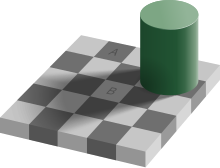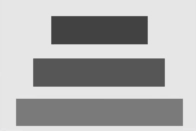အမြင်ပိုင်းဆိုင်ရာ လှည့်စားမှု
အမြင်ပိုင်းဆိုင်ရာ လှည့်စားမှု (အင်္ဂလိပ်: optical illusion or visual illusion)[၂]) သည် အမြင်စနစ်က ဖြစ်ပေါ်စေသော လှည့်စားမှုတစ်ခုဖြစ်၍ မြင်လိုက်ရသည့်အရာသည် အရှိတရားမှ အငြင်းပွားဖွယ် ကွဲပြားနေဟန်တူနေသော အသွင်ကိုဆောင်သည်။ လှည့်စားမှုများမှာ အမျိုးမျိုးအစားစားဖြစ်နေတတ်သည်။ ဖြစ်ပေါ်စေသော အခြေခံအကြောင်းတရားများသည် များသောအားဖြင့် ရှင်းရှင်းလင်းလင်းမရှိတတ်သောကြောင့် အမျိုးအစား အတိအကျခွဲရန်မှာ ခက်ခဲသည်။[၃] သို့ရာတွင် ရစ်ချက် ဂရက်ဂရီတင်ပြသော အမျိုးအစားခွဲခြားခြင်းမှာ အသုံးဝင်သည်။[၁][၄] ၎င်းစနစ်တွင် အဓိက အမျိုးအစား သုံးခုပါဝင်ရာ ၎င်းတို့မှာ ရုပ်ပိုင်းဆိုင်ရာ အမြင်လှည့်စားမှု (physical)၊ ဇီဝကမ္မပိုင်းဆိုင်ရာ အမြင်လှည့်စားမှု (physiological) နှင့် စိတ်အာရုံ (အမြင်) မှနားလည်လိုက်သော အမြင်လှည့်စားမှု (cognitive) တို့ဖြစ်ကာ တစ်ခုစီတွင် အမျိုးအစား လေးမျိုးစီထပ်မံရှိသည်။ မရေမရာမပြတ်သားမှုများ (Ambiguities) ၊ နဂိုအတိုင်းမဟုတ်မှုများ (distortions) ၊ မဖြစ်နိုင်မှုများ (paradoxes) ၊ ပွတ်တိုက်မှုများ (fictions) (လှုံဆော်မှုမရှိသောအခါတောင်မှ အာရုံတွင် မြင်နေမှု) တို့ဖြစ်ကြသည်။[၄] ရုပ်ပိုင်းဆိုင်ရာ နဂိုအတိုင်းမဟုတ်ခြင်းအတွက် အစဉ်ဆက်ပြသသော နမူနာတစ်ခုမှာ အချောင်းတစ်ချောင်း၏ တစ်ဝက်ကို ရေတွင်နစ်လိုက်သောအခါ ကွေးသွားသည့်ပုံစံဖြစ်သည်။ ဇီဝကမ္မပိုင်း မဖြစ်နိုင်ခြင်းသည် 'ရွေ့ရှားမှု နောက်ဆက်တွဲအကျိုး' (motion aftereffect) ဖြစ်၍ ပုံ(ရုပ်သံ)ကို စူးစိုက်အချိန်ကြာကြည့်ပြီးနောက် အပြင်သို့ပြန်ကြည့်သော အခါ ပုံ၌ပါသော အရာ၏ လှုပ်ရှားမှု အမြင်တစ်မျိုးကို ဖြစ်စေသည်။[၄] ဇီဝကမ္မပွတ်တိုက်မှု ဥပမာမှာ 'ပုံရိပ် နောက်ဆက်တွဲအကျိုး' (afterimage) ဖြစ်သည်။[၄] စံပြအနေဖြင့် စိတ်အာရုံ(အမြင်)မှ နားလည်လိုက်သော ဥပမာသုံးခုမှာ Ponzo လှည့်စားမှု၊ Poggendorff လှည့်စားမှု နှင့် Müller-Lyer လှည့်စားမှုတို့ဖြစ်ကြသည်။[၄] ရုပ်ပိုင်းဆိုင်ရာ လှည့်စားမှုများမှာ ရုပ်ပိုင်းဆိုင်ရာ ပတ်ဝန်းကျင်မှ ဖြစ်ပေါ်စေသည်။ ဥပမာအားဖြင့် ရေ၏ ရုပ်ပိုင်းဆိုင်ရာ ဂုဏ်သတ္တိများ ကြောင့်ဖြစ်သည်။[၄] ဇီဝကမ္မပိုင်း လှည့်စားမှုသည် မျက်လုံး၌သော်လည်းကောင်း မြင်သည့်လမ်းကြောင်း၌သော်လည်းကောင်း ဖြစ်ပေါ်တတ်၍ နမူနာအားဖြင့် အမြင်အာရုံကို သီးသန့်လက်ခံသော အမျိုးအစားကို အလွန်အကျွံ လှုံ့ဆော်ခံရမှုအကျိုးမှ ဖြစ်ပေါ်စေသည်။[၄] စိတ်အမြင်အာရုံမှ လက်ခံနားလည်လိုက်သော လှည့်စားမှုမှာ 'အလိုအလျောက် ကောက်ချက်ဆွဲမှု' ၏ ရလဒ်ဖြစ်ကာ ဤလှည့်စားမှုမှာ လူအများ အသိများဆုံးအရာများ ဖြစ်နိုင်ပေသည်။[၄]




ရောဂါကြောင့်ဖြစ်သော အမြင်ဆိုင်ရာ လှည့်စားမှုသည် ဇီဝကမ္မဆိုင်ရာ အမြင်တစ်ခုကို နားလည်လက်ခံသည့် ယန္တယားစနစ်တွင် ရောဂါ၏ ပြောင်းလဲမှုများမှ ပေါ်ပေါက်လာသည်။ (စိတ်အာရုံထွေပြားချောက်ခြားခြင်း၊ အပြင်တွင် တကယ်မရှိဘဲ စိတ်၌ ရှိသယောင် မြင်နေခြင်း)
အမြင်ပိုင်းဆိုင်ရာနှင့် ၎င်းပါဝင်ပတ်သတ်သည့် များစွာသောအာရုံပိုင်းဆိုင်ရာ လှည့်စားမှုကို စစ်ဆေးမှုများ၊ ပြတ်တောက်သွားသော လက်/ခြေ (ကို ရံခါ ပြန်ရ၊ ပြန်ခံစားရ သည်ဟု ထင်မြင်သော) ရောဂါ (phantom limb syndrome) ၊ schizophrenia ကဲ့သို့သော စိတ်ပိုင်းဆိုင်ရာ မူမမှန်မှုများကို ပြန်လည်ပြုစု ပျိုးထောင်ပေးရာတွင် အသုံးချနိုင်ကြသည်။[၅] [၆]
ပြခန်း
ပြင်ဆင်ရန်-
Motion aftereffect: this video produces a distortion illusion when the viewer looks away after watching it.
-
Ebbinghaus illusion: the orange circle on the left appears smaller than that on the right, but they are in fact the same size.
-
Café wall illusion: the parallel horizontal lines in this image appear sloped.
-
Checker version: the diagonal checker squares at the larger grid points make the grid appear distorted.
-
Checker version with horizontal and vertical central symmetry
-
Lilac chaser: if the viewer focuses on the black cross in the center, the location of the disappearing dot appears green.
-
Motion illusion: contrasting colors create the illusion of motion.
-
Watercolor illusion: this shape's yellow and blue border create the illusion of the object being pale yellow rather than white[၇]
-
Optical illusion disc which is spun displaying the illusion of motion of a man bowing and a woman curtsying to each other in a circle at the outer edge of the disc, 1833
-
A hybrid image constructed from low-frequency components of a photograph of Marilyn Monroe (left inset) and high-frequency components of a photograph of အိုင်းစတိုင်း (right inset). The Einstein image is clearer in the full image.
-
An ancient Roman geometric mosaic. The cubic texture induces a Necker-cube-like optical illusion.
-
A set of colorful spinning disks that create illusion. The disks appear to move backwards and forwards in different regions.
-
Pinna-Brelstaff illusion: the two circles seem to move when the viewer's head is moving forwards and backwards while looking at the black dot.[၁၂]
-
The Spinning Dancer appears to move both clockwise and counter-clockwise
-
Forced perspective: the man is made to appear to be supporting the Leaning Tower of Pisa in the background.
-
တလက်လက်တောက် လေးထောင့်ကွက် လှည့်စားမှု: Dark dots seem to appear and disappear rapidly at random intersections, hence the label "scintillating".
ကိုးကား
ပြင်ဆင်ရန်- ↑ ၁.၀ ၁.၁ "Putting illusions in their place" (1991). Perception 20 (1): 1–4. doi:. PMID 1945728.
- ↑ In the scientific literature the term "visual illusion" is preferred because the older term gives rise to the assumption that the optics of the eye were the general cause for illusions (which is only the case for so-called physical illusions). "Optical" in the term derives from the Greek optein = "seeing", so the term refers to an "illusion of seeing", not to optics as a branch of modern physics. A regular scientific source for illusions are the journals Perception and i-Perception
- ↑ "Optical Illusions" (2006). Adv. Clin. Neurosci. Rehabil. 6 (2): 20–21. Archived 20 January 2021 at the Wayback Machine. မော်ကွန်းတင်ပြီးမိတ္တူ။ 20 January 2021 တွင် မူရင်းအား မော်ကွန်းတင်ပြီး။ 14 August 2020 တွင် ပြန်စစ်ပြီး။
- ↑ ၄.၀ ၄.၁ ၄.၂ ၄.၃ ၄.၄ ၄.၅ ၄.၆ ၄.၇ "Visual illusions classified" (1997). Trends in Cognitive Sciences 1 (5): 190–194. doi:. PMID 21223901. Archived 12 July 2019 at the Wayback Machine. မော်ကွန်းတင်ပြီးမိတ္တူ။ 12 July 2019 တွင် မူရင်းအား မော်ကွန်းတင်ပြီး။ 14 August 2020 တွင် ပြန်စစ်ပြီး။
- ↑ DeCastro, Thiago Gomes; Gomes, William Barbosa (2017-05-25). "Rubber Hand Illusion: Evidence for a multisensory integration of proprioception". Avances en Psicología Latinoamericana. 35 (2): 219. doi:10.12804/revistas.urosario.edu.co/apl/a.3430. ISSN 2145-4515.
- ↑ King, Daniel J.; Hodgekins, Joanne; Chouinard, Philippe A.; Chouinard, Virginie-Anne; Sperandio, Irene (2017-06-01). "A review of abnormalities in the perception of visual illusions in schizophrenia". Psychonomic Bulletin & Review. 24 (3): 734–751. doi:10.3758/s13423-016-1168-5. ISSN 1531-5320.
- ↑ "Surface color from boundaries: a new watercolor illusion" (2001). Vision Research 41 (20): 2669–2676. doi:. PMID 11520512.
- ↑ Hoffmann၊ Donald D. (1998)။ Visual Intelligence. How we create what we see။ Norton။, p.174
- ↑ "Neural Dynamics of Gestalt Principles of Perceptual Organization: From Grouping to Shape and Meaning" (2012). Gestalt Theory 34 (3+4): 399–482. Archived 4 October 2013 at the Wayback Machine. မော်ကွန်းတင်ပြီးမိတ္တူ။ 4 October 2013 တွင် မူရင်းအား မော်ကွန်းတင်ပြီး။ 14 August 2020 တွင် ပြန်စစ်ပြီး။
- ↑ Pinna, B., Gregory, R.L. (2002). "Shifts of Edges and Deformations of Patterns". Perception 31 (12): 1503–1508. doi:. PMID 12916675.
- ↑ "Pinna illusion" (2009). Scholarpedia 4 (2): 6656. doi:.
- ↑ "A new visual illusion of relative motion" (2000). Vision Research 40 (16): 2091–2096. doi:. PMID 10878270. မော်ကွန်းတင်ပြီးမိတ္တူ။ 5 October 2013 တွင် မူရင်းအား မော်ကွန်းတင်ပြီး။ 14 August 2020 တွင် ပြန်စစ်ပြီး။
| ဤ ဆောင်းပါးမှာ ဆောင်းပါးတိုတစ်ပုဒ် ဖြစ်သည်။ ဖြည့်စွက်ရေးသားခြင်းဖြင့် မြန်မာဝီကီပီးဒီးယားကို ကူညီပါ။ |